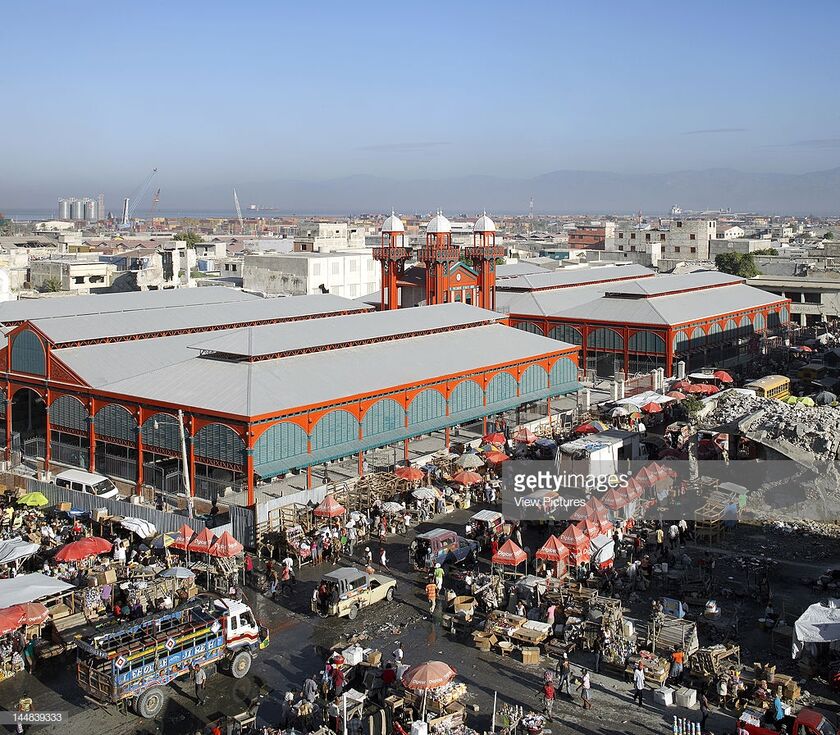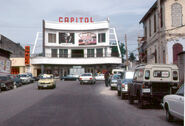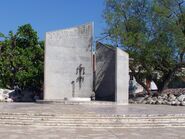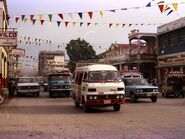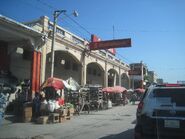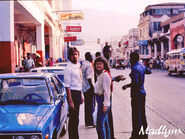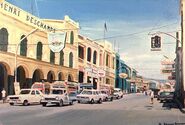La Ville de Port-au-Prince, or Downtown Port-au-Prince is the city center of Haiti's capital. Nearly a million people inhabit this tiny area.


The city of Port-au-Prince was founded in 1749. The largest of the city's commercial districts, Downtown is the location of many state and federal government facilities; and many of Port-au-Prince's tourist attractions. Similar to other central business districts in Haiti, Downtown will undergo a transformation that includes the construction of new homes, renovation of historic buildings, and arrival of new residents and businesses.
Clockwise from the north, Downtown is bound by the Croix-des-Bossales, Bél-Air, Bois-Verna, and the Bolosse areas.
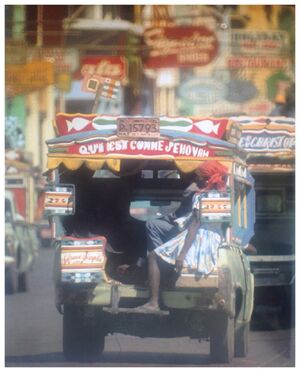
Port-au-Prince 1975.

Miss Haiti Claudinette Fouchard-Ebony 1960 Haiti History, Vintage Black Glamour, Ebony Magazine
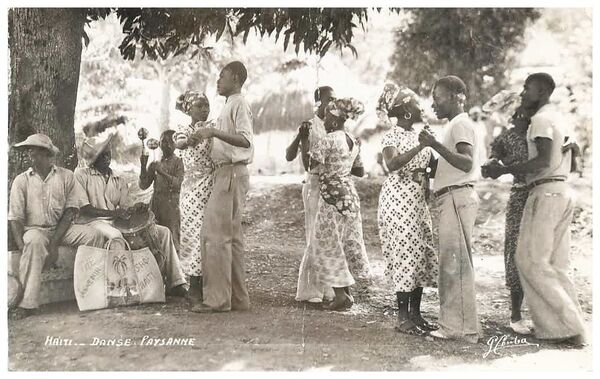
Haitians dancing. Port-au-Prince, 1954
History[]
Fort Lerebours[]
Located in Port-au-Prince, at Portail Léôgane, the southern end of the Grande Rue. It was first of all a redoubt; under President Boyer, it was restored, as it is today, by General Lerebours.
• On February 5, 1802, when the French army landed at Lamentin, General Boudet sent Calvary Colonel d'Henin to Fort Leogane (Lerebours) with the mission of receiving the submission of the troops who occupied it. Lamartiniere appeared in the redoubt and prepared the combatants. Colonel d'Henin, arriving at the foot of the fort, asked to speak to the one in command. Lamartiniere introduced himself. D'Henin threw his sword away from him, and asked to enter the fort in the midst of his compatriots: "We come together Brothers, to increase, by mixing with you, the number of defenders of the fatherland."- a No! no ! cried the soldiers. Boudet called D'Henin. Only thing heard was this command: "Grenadiers, forward to the bayonet!" At the same instant Magny arrived: "Halt", he cried, "halt, my friends, my brothers!" by addressing the French. His voice was muffled by the noise of the drums; the French column had arrived at the foot of the fort. "Fire! Fire!" Magny ordered. Death ravaged the ranks of the French. The column was pushed back under the machine-gun, leaving the road strewn with corpses.
The French squadron, embossed along the reefs which separate the two harbors, after having silenced Fort Sainte-Claire, directed its fire at Fort Leogane (Lerebours); the projectiles went, falling beyond the redoubt. The French returned to the charge. In the middle of the grapeshot and a hail of bullets, General Boudet advanced at the head of his grenadiers, the bayonet in front. He mounted the assault, and removed the redoubt. Without losing a moment, he entered the city.
• General Antoine Lerebours, commander of the district of Port-au-Prince for 12 years, under President Boyer, was buried there, as well as other notables.
• Guerrier Macombe, an officer devoted to President Salnave, had him rescued, near the entrance to the Cacos in Port-au-Prince, on December 18, 1869. The Bois-de-Chène flows at the foot of the fort, to the south.
Portail Saint-Joseph[]
Fort located at the north gate of the main street of Port-au-Prince. The same as Fort Lamarre.
• In January 1792, the gens de couleur camped at Croix-des-Bouquets, sent Pinchinat to Port-au-Prince to ask a truce to the whites, municipality; instead of letting him enter the city, as was agreed, they had shot him with all the cannons of Fort Saint Joseph. Nevertheless Pinchinat returned safely to the Croix-des-Bouquets.
• On June 5, 1794, Blaise, lieutenant colonel of the legion of the Ouest, delivered the fort to the English. A colonel named Béranger went there that day, and in the midst of all the whites who had called the English in the colony, he read a list of thirty planters, his old friends, who were, he said, republicans. He began with Misters Goy and Gau. He had them thrown into the pit after having burned their brains with his own hand, and said to each of them: "Republican, make the jump from the Roche Tarpéienne". He had thus killed all those unfortunates who had betrayed the country. If General Whyte, arriving in the fort at 8 o'clock in the evening ... had put an end to this frightful carnage. The English general had him arrested; the next day he published a proclamation by which he condemned his crimes. Béranger fled; he drowned in the Voldrogue on his way to Jérémie.
• On February 5, 1802, when the French army landed at Lamentin, the garrison of the fort had been won by the citizens. The 3rd colonial had pulled from the place Vallière on the French, and had retired in the fort. The garrison let the soldiers of the 3rd penetrate in the middle of it, they, feeling no distrust, and believing themselves with brothers, suddenly turned the cannons against them, at the same time the French who already surrounded the fortification, summoned them to lay down their arms, which was done.
• In 1807, after the battle of Sibert, in the midst of the resistance preparations that the troops were making at the Saint Joseph Gate against Christopher's army, a woman, Manette Bonnaire, who had her son in the army, came to the Saint Joseph gate ask what had become of General Pétion. "What do you ask for your son's news," they tell him. My son! Re-minded this Spartan mother, shrugging her shoulders, what does her life matter to the republic? It is the general's life which is precious. "The public danger said that it was feared that Pétion would remain among the dead at Sibert, she fell unconscious. Fort Saint Joseph pushed back Christophe's troops in 1807 and 1812. The heart of General Lamarre, the defender of Môle Saint-Nicolas was buried at Fort Saint Joseph, since called Fort Lamarre. Other officers were also buried there.
• St. Joseph's Church, built west of the fort, was the most beautiful of the republic. Burned, it was rebuilt. The rural sections of Pont-Rouge, Varreux, Saint Martin, Grand Riviere depend on the parish of Saint Joseph and the posts of Pont-Rouge and Croix-des-Missions.
• On the other side of the Saint Joseph Gate is La Saline, where in 1882 many land concessions were made, to the point where today a hamlet called Bourg Salomon has been built with a very dense population. The population between the gate and the Red bridge is also very active. Many municipalities do not matter. There is a public fountain.
• The abbot Guilard, cure of the Saint-Joseph parish, died October 15, 1888. The commune of Port-au-Prince, grateful for the services rendered to the country by this green priest, gave him the day after the official funerals. Father Guillard occupies an eminent rank among the founders of the church and the Saint Joseph parish. He contributed to the purification of morals in this district, which had been completely delivered to him. His body was buried the next Sunday on the right of the altar of the Virgin.

Port-au-Prince 1950.

Downtown Port-au-Prince at night
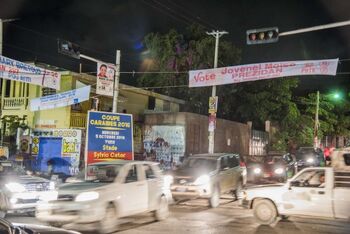
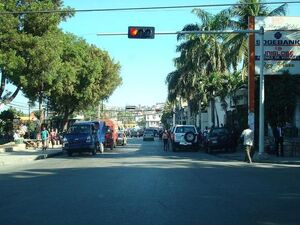
Rue Capois, Champs de Mars
Neighboring sections
|
|---|

Mariott Hotel. Port-au-Prince, Haiti
Recreation[]
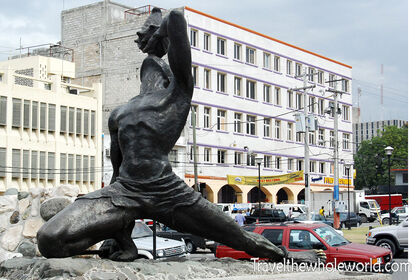
Slave statue; Port-au-Prince, Haiti
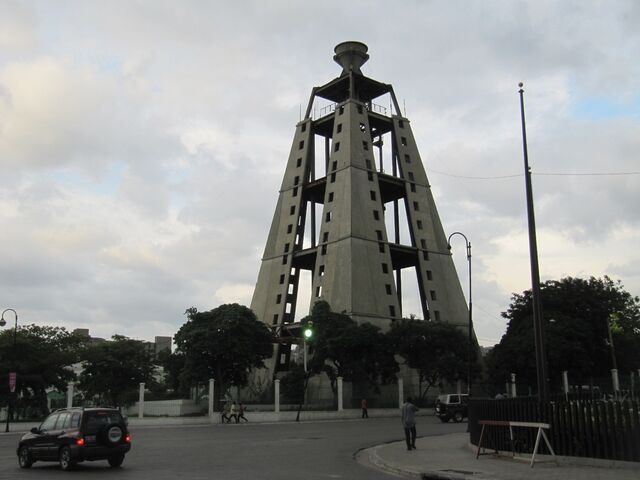
Downtown Port-au-Prince, Haiti

Grande Cimetière, PAP
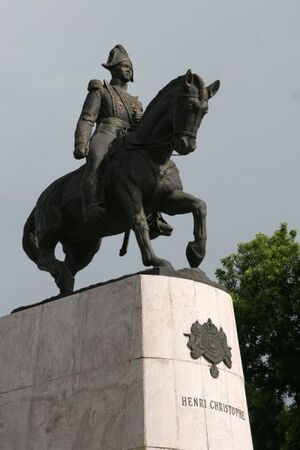
Statue of Henri Christophe - Champs de Mar

Constitution Monument, PAP
Fort Ilet[]
Fort Ilet is a fortress built under the French colony on one of the islands then called Ilet du Prince, in the harbor of Port-au-Prince.
This lot contains about 1 tile of land with coconut palms and fruit trees. The fortress has been disarmed for a long time and serves as a coal depot for the warships of the State and those of the fast line. Mr. B. Rivière, the concessionaire of this line, had established a forge and a repair shop for his boats there. He sold his establishment to the State, however Mr. Rivière continues to enjoy his property conveniently. If someone had the good idea, said the Courrier d'Haiti newspaper of November 24, 1887, to install a small restaurant there, this place would become a charming destination for a walk in the harbor of Port-au-Prince.
To enter the port of Port-au-Prince, ships are forced to pass 50 fathoms south of Fort Ilet to avoid the reefs.
Since May 15, 1888, a new lighthouse was lit for the duration of the nights, at the top of a round iron tower, painted white, erected on Fort Islet. This headlight, a 5th order device, has a fixed green light. Itsosition according to the Directory of the Bureau of Longitudes of 1888: Lat. N. 18° 33' 54"; Long. W., 74° 42' 16". height of the hearth above the crest of the fort, 9 m. 50. Height of fireplace above highest tide, 14 meters. Average range: 11 miles. —
On January 2, 1794, Sonthonax entrusted Fort Ilet to Captain Adelou to resist Commodore Ford. During the second appearance of this commodore in the port, on May 31, Fort Ilet pushed back a parliamentary boat of the English general.
